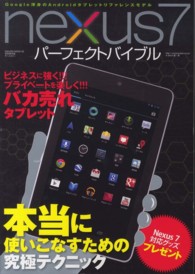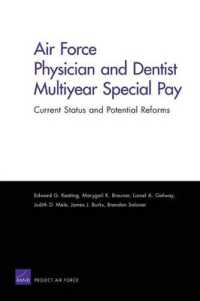- ホーム
- > 洋書
- > 英文書
- > Science / Mathematics
Full Description
Based on the author's work in science and engineering educational research, this book offers broad, practical strategies for teaching science and engineering courses and describes how faculty can provide a learning environment that helps students comprehend the nature of science, understand science concepts, and solve problems in science courses.
This book's student-centered approach focuses on two main themes: writing to learn (especially Reflective Writing) and interactive activities (collaborative groups and labatorials). When faculty incorporate these methods into their courses, students gain a better understanding of science as a connected structure of concepts rather than as a toolkit of assorted practices.
Contents
Part I. Introduction, Road Map of the Book.
Writing to Learn.
Two Goals for Any Science and Engineering Course.
Questions by Students.
What Students Get Out of Class.
In-Class and Out-of-Class Activities.
Solving Problems.
Computer Aids.
Part II. Reflective Writing.
Freewriting.
Getting Students to Read Material in the Textbook Before Coming to Class.
Gadamer's Hermeneutical Approach.
Instructions on Doing Reflective Writing.
Samples of Student Use of Reflective Writing.
Marking Reflective Writing.
Student Response to Reflective Writing.
Reflective Writing Rubric.
Part III. Writing to Learn.
Reflective Write-Pair-Share.
Scenario for a Class.
The Course Dossier Method.
Transforming Each Lecture Into a Mini Research Paper.
End of Semester.
Hosting an End of Semester Conference.
Part IV. Constructing Student Knowledge.
Cognitive Dissonance Students' Intellectual Development.
Student Misconceptions.
Debate in the Science Education Community.
Critical Thinking.
Part V. Collaborative Groups.
Team Work and Group Projects Benefits to Having Students Work in Groups.
Team Formation.
Team Size.
Team Management.
Team Evaluation.
Group Development.
Classroom Warmups.
Roles for Group Member.
Dysfunctional Groups.
Part VI. Utilizing Collaborative Groups to Promote Conceptual Conflict.
Conceptual Conflict.
Peer Instruction.
Collaborative Group Conceptual Conflict Activity.
Comparison of Peer Instruction With the Conceptual Conflict Group Activity.
Incommensurability in Conceptual Change.
Task Sheets for Warm-Up and the Four Concept Exercises.
Part VII. Selected Methods of Utilizing Collaborative Groups.
Labatorials.
Jigsaw.
The Learning Cell.
Concept Mapping.
Collaborative Concept Mapping.
Appendix.
Sample Labatorial Worksheet.
Part VIII. Changing Students' Epistemologies.
Developing a Scientific Mindset.
Stages in Epistemic Development in Students.
Critique Exercise.
Model Course: Presenting Students With Alternative Frameworks: Pre-Galilean Physics and Newtonian Physics.
The Calgary Study: Reflective Writing and Labatorials.
Epistemology.
Critique Exercise.
Students' Epistemic Thinking.
Appendix: Critique #1.
Critique #2.
Critique #3.
Part IX. Problem Solving.
Solving Problems Using Templates Versus Solutions.
Using Paradigms.
Five-Step Method for Solving Problems.
Part X. Methods for Training Students to Solve Problems.
Writing Their Way Into the Solution.
Collaborative Problem-Solving Groups.
How Many People Should Be in the Group? Who Should Be Placed in the Group? Individual Accountability.
Appendix.
A Student's Advice for Studying Physics.
Part XI. Using the Computer to Aid Teaching.
Computer-Assisted Instruction (CAI).
Using the Computer to Manage Laboratories.
References.







